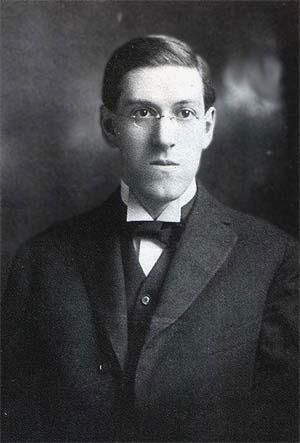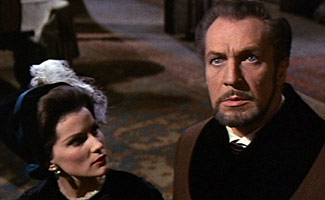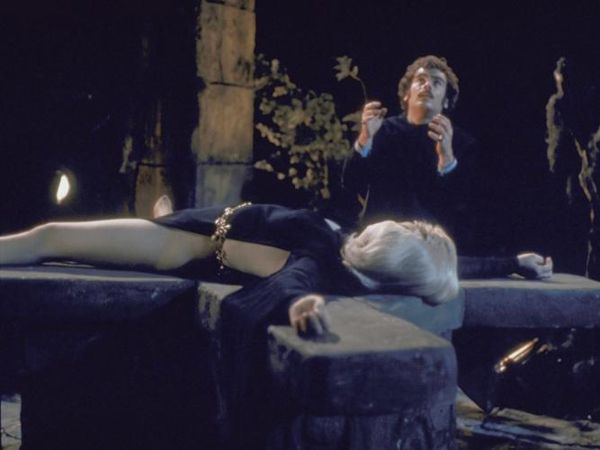Why
We Love Being Scared and the Movies Based on That Love
By
Steve Herte
My
teenage obsession with the cosmic horror tale imagined by Howard
Phillips Lovecraft stems from when I found The
Complete Works of Edgar Allan Poe in
our basement and read it from cover to cover. Poe fascinated me and
still does; and I believe he must have been a major influence on
Howard Phillips Lovecraft. Poe was long gone when Lovecraft was born,
but if you read “The Narrative of Arthur Gordon Pym of Nantucket”
(1838) and then pick up “At the Mountains of Madness” (1931) by
Lovecraft you will find that they link together nicely. Both tales
take place in Antarctica and both involve a hidden malevolent
creature identifiable only by the chilling sound it makes, which both
authors quote verbatim.
I
don’t remember who among my high school friends recommended
Lovecraft to me, but I recall becoming hooked on “The Colour from
Out of Space” and went on to collect every book and collection of
his wonderfully creepy stories. I learned later on that my current
favorite author, Stephen King, is quoted as calling Lovecraft “the
twentieth century’s greatest practitioner of the classic horror
tale” and that he was responsible for King’s own bent toward the
macabre, as he made clear in his semi-autobiographical Danse
Macabre.
Born in Providence, Rhode Island, on August 20, 1890, to Winfield Scott
Lovecraft, a travelling salesman, and Sarah Susan Phillips Lovecraft
of Massachusetts Bay Colony descent, Howard lost his father quite
early. Winfield was hospitalized with psychosis in 1893 and died of a
paralysis brought on by syphilis (they called “nervous exhaustion”
back then).
Raised
by his mother, two aunts, and a maternal grandfather who introduced
him to Gothic Horror, Howard was encouraged to read and read
voraciously, especially during his frequent periods of illness,
becoming interested in chemistry and astronomy. His sleep was
disturbed by night terrors, which would eventually inspire him to
write the poem “Night Gaunts.”
With
the trauma of his grandfather’s death in 1904 and the resulting
impoverishment due to mismanagement of the estate, the family was
forced to move to smaller living quarters. The higher mathematics he
needed to become a professional astronomer eluded him and caused a
“nervous breakdown” that would ultimately cost him his high
school diploma. Living a reclusive life with his mother, he wrote
mainly poetry until 1913. Then a letter of complaint he wrote to a
pulp magazine, “The Argosy,” got the notice of editor Edward F.
Daas, who invited him to join the United Amateur Press Association.
Thus, in 1917, Howard was writing fiction stories including “The
Tomb” and “Dagon” (his first published work).
In
his own words:
“In
1914, when the kindly hand of amateurdom was first extended to me, I
was as close to the state of vegetation as any animal well can be...
With the advent of the United I obtained a renewal to live; a renewed
sense of existence as other than a superfluous weight; and found a
sphere in which I could feel that my efforts were not wholly futile.
For the first time I could imagine that my clumsy gropings after art
were a little more than faint cries lost in the unlistening world.”
His
frequent letters drew a coterie of correspondents that included
Robert Bloch (who wrote “Psycho”), Clark Ashton Smith, and Robert
E. Howard (responsible for “Conan the Barbarian”). Things were
looking up until 1919, when Howard’s mother, after bouts of
hysteria and depression, was committed to the same hospital where his
father died. She succumbed of complications from gall bladder surgery
in 1921.
A
few weeks later, Lovecraft met Sonia Greene at a convention in Boston
and though he was seven years her junior, they married in 1924 and
moved into her Brooklyn, New York, apartment. Howard’s initial
delight in New York turned into intense dislike when Sonia’s poor
health, her stay in a New Jersey sanitarium, and financial hardship
(she lost her hat shop) forced her to move to Cleveland for
employment, leaving him alone in then-seedy Red Hook. This, coupled
with his inability to find work, spawned the short stories, “The
Horror at Red Hook” and “The Shunned House.” Also during this
period he wrote “Cool Air,” “Herbert West – Re-Animator,”
“The Unnamable,” “The Lurking Fear,” “The Outsider,” and
“The Hound.” He returned to Providence in 1927 and the two agreed
to divorce. The best part of Howard’s New York experience was his
association with a group of men dubbed the Kalem Club, which included
his protégé Frank Belknap Long and several friends who encouraged
him to publish in “Weird Tales,” another celebrated pulp
magazine.
The
last 10 years of Lovecraft’s life were the “big bang” of his
writing career and included such stories as “The Dunwich Horror,”
“The Colour Out of Space,” “The Call of Cthulhu,” and the
novellas The Shadow Over Innsmouth, The Shadow Out of Time,
and At the Mountains of Madness. Also during this period he
ghosted “The Mound,” “Winged Death,” “The Diary of Alonzo
Typer,” and “Under the Pyramids” (written for Harry Houdini),
and his only novel The Case of Charles Dexter Ward. His
travels to Quebec, Charleston, St. Augustine and venerable sites in
New England provided enhanced settings for his tales. Again,
financial hardships forced him to downsize living arrangements with
his surviving aunt. If this weren’t enough, he learned of the
suicide of Robert E. Howard. Cancer of the small intestine and its
resulting malnutrition caused Lovecraft constant pain until his death
on March 15, 1937.
I
can’t help but wonder if Lovecraft noticed the parallels to Poe’s
life in his own: the loss of his father, being raised mainly by
women, financial difficulties, and frequent moving. But as they say
about blues musicians, “You have to pay your dues to sing the
blues.” Howard experienced horror in his own life, which gave him a
deep well from which to draw his terrifying stories such as “The
Beast in the Cave” (1905) and “The Alchemist” (1908). His
imagination was limitless. In his early years he created the ultimate
evil book The Necronomicon, first mentioned in the short story
“The Hound” (1924), supposedly written by the mad Arab Alhazred
(actually a pseudonym for himself at the age of five) and
incorporated so thoroughly into his stories that one would believe
that such a book actually existed (I actually thought I found it in
the Boston Main Library). Robert Bloch created the mythical book and
equally loathsome tome De Vermis Mysteriis in his “The
Shambler from the Stars” (1935) and Lovecraft adopted it into his
mythos of Cthulhu, an ancient horror and extra-dimensional Elder God.
Lovecraft’s
nurturing of Robert Bloch, August Derleth, Fritz Leiber and Donald
Wandrei not only caused their careers to blossom but thanks to them,
the “Cthulhu Mythos” was continued and spread as each author
incorporated part of Lovecraft’s pantheon of elder gods and
unnamable horrors. It was through them that Arkham House Publishing
Company was formed (Arkham is Lovecraft’s renaming of Salem) and
Lovecraft’s stories were finally put into book format, albeit
post-mortem, in “The Outsider and Others” (1939). His novella,
The Shadow over Innsmouth (1936), was the closest he came to
publishing a book during his lifetime.
Other
authors who were touched by and whose writings were affected by (and
whose names were changed and incorporated into his stories) included
Arthur Machen and Edward John Moreton Drax Plunkett (known as Lord
Dunsany). Even after the last of these men, Bloch, died in 1994, the
Cthulhu Mythos continued on and the “Great Old One”
appeared in the South Park episode “Mysterion Rises”
(November 3, 2010), the second part of a three-part arc beginning
with “The Coon” and followed by “Coon 2: Hindsight.” An
oil-drilling company that caused a major spill in the Gulf of Mexico
releases him when they mistakenly think that drilling on the Moon
will fix their former error.
Thus
did Poe lead me to Lovecraft and thence to Bloch, who I understand
completed Poe’s unfinished final tale “The Lighthouse” in 1977
under the title “The Horror in the Lighthouse.” I’m currently
in the process of obtaining that story.
Movies:
Though
there have been many adaptations of Lovecraft’s work, as seen
below, practically none are of first-rate quality, excepting the
first listed, The Haunted Palace. The rest have simply served
as excuses for gross-out horror. None have done well at the
box-office, while several went straight to video. The only adaptation
that has any sort of reputation among film fans and especially those
of horror, is The Re-Animator, which has gained a cult
following over the years.
The
Haunted Palace (AIP, 1963): Although writer Charles Beaumont
took a few lines from Poe’s 1839 mood poem and had Vincent Price
recite them near the end, the film is actually based on Lovecraft’s
story “The Case of Charles Dexter Ward.” Directed by Roger
Corman.
Die,
Monster, Die, aka Monster of
Terror (AIP, 1965): A very loose adaptation of “The
Colour Out of Space.”
The
Dunwich Horror (AIP, 1970) Well, it’s based on “The
Dunwich Horror.” IMDB provides the perfect synopsis: H.P.
Lovecraft meets Hollywood: Wilbur Whateley wants to help the Old Ones
break through by consulting the Necronomicon, and Dr. Armitage must
stop him. Attractive females are added to fill out the plot.
Island
of the Fishmen, aka Screamers, from
the Italian L’isola degli uomini pesce (Dania
Film,1979): A mish-mosh of Lovecraft’s “The Shadow over
Innsmouth” and The Island of Doctor Moreau by H.
G. Wells.
Re-Animator (Empire
Pictures, 1985): Based on “Herbert West – Re-Animator.”
From
Beyond (Empire Picture, 1986): Based on “From Beyond.”
Curse (TWE,
1987): Loosely based on “The Colour Out of Space.”
The
Unnamable (Image Entertainment, 1988): Based on “The
Unnamable.”
Pulse
Pounders (Empire Pictures, 1988): Based on “The Evil
Clergyman.”
Bride
of Re-Animator (Artisan, 1989): Sequel to Re-Animator.
The characters are from Lovecraft, but the story is original.
Dark
Heritage (Sterling Pictures, 1989): Based on “The
Lurking Fear.”
Shatterbrain aka The
Resurrected ( Lions Gate, 1991): Based on “The Case of
Charles Dexter Ward.”
The
Unnamable II: The Statement of Randolph Carter (Lions
Gate,1993): Again, a sequel with only Lovecraftian characters, not
the story.
Necronomicon:
Book of the Dead (August Entertainment, 1993): An
original story based on the concept.
Lurking
Fear (Full Moon Entertainment, 1994): Based on “The
Lurking Fear.”
Castle
Freak (Full Moon Entertainment, 1995): Based only
slightly on “The Outsider.”
Bleeders aka Hemoglobin (A-Pix
Entertainment, 1997): Based on “The Lurking Fear.”
Cool
Air (Lurker Films, 1999): Based on “Cool Air”
(1926) and written during his unhappy stay in New York.
Rough
Majik aka Dreams of Cthulhu Volume 2 (Lurker
Films, 2000): A TV short based on the works of Lovecraft and the Cult
of Cthulhu, but no particular story.
Dagon (Lions
Gate, 2001): Based on “Dagon” and “The Shadow over Innsmouth.”
Beyond
Re-Animator (Lions Gate, 2003): Another sequel with only
characters by Lovecraft.
The
Call of Cthulhu (MicroCinema, 2005): Based on “The
Call of Cthulhu.”
Masters
of Horror, Episode 2 (IDT Entertainment, 2005): A TV
series. The second episode is based on “Dreams in the Witch House.”
Beyond
the Wall of Sleep (Lions Gate, 2006): Based on “Beyond
the Wall of Sleep.”
Cthulhu (Regent
Releasing, 2007): Based loosely (very loosely) on “The Shadow over
Innsmouth.”
Chill (Rojak
Films, 2007): Another adaptation of “Cool Air. ”
Colour
from the Dark (Vanguard Cinema, 2008): Italian version
of “The Colour Out of Space.”
Beyond
the Dunwich Horror (Scorpio Film Releasing, 2008): A
better adaptation than the first The Dunwich Horror.
The
Dunwich Horror (Active Entertainment, 2009): A TV movie
based on “The Dunwich Horror.”
The
Color Out of Space (Brinkvision, 2010): German
version of “The Colour Out of Space.”
The
Whisperer in Darkness (MicroCinema, 2011): Based on “The
Whisperer in Darkness.”
13:
de mars, 1941 (Big Belly Film, 2004): A Swedish film
“inspired” by the works of Lovecraft.
Kammaren (Big
Belly Film, 2007): Another Swedish film only “inspired” by the
works of Lovecraft.
Fyren (Big
Belly Film, 2010): Yet another Swedish film “inspired” by
Lovecraft with overtones of Edgar Allen Poe’s last tale “The
Lighthouse.”
In
addition, Rod Serling’s excellent series, Night Gallery,
featured two faithful adaptation of Lovecraft:
“Pickman’s
Model” (Season 2, Episode 11): Lovelorn Mavis Goldsmith
ignores her reclusive art teacher Pickman's warning not to follow him
home.
“Cool
Air” (Season 2, Episode 12): A Gothic love story about a woman and
a man who lives in a refrigerated apartment.




Does anyone know exactly how many gold snake belts that were made for Sandra Dee in the 1970's movie the Dunwich Horror??
ReplyDeleteAlso does anyone know how to identify which belts and robes were actually used in this movie??